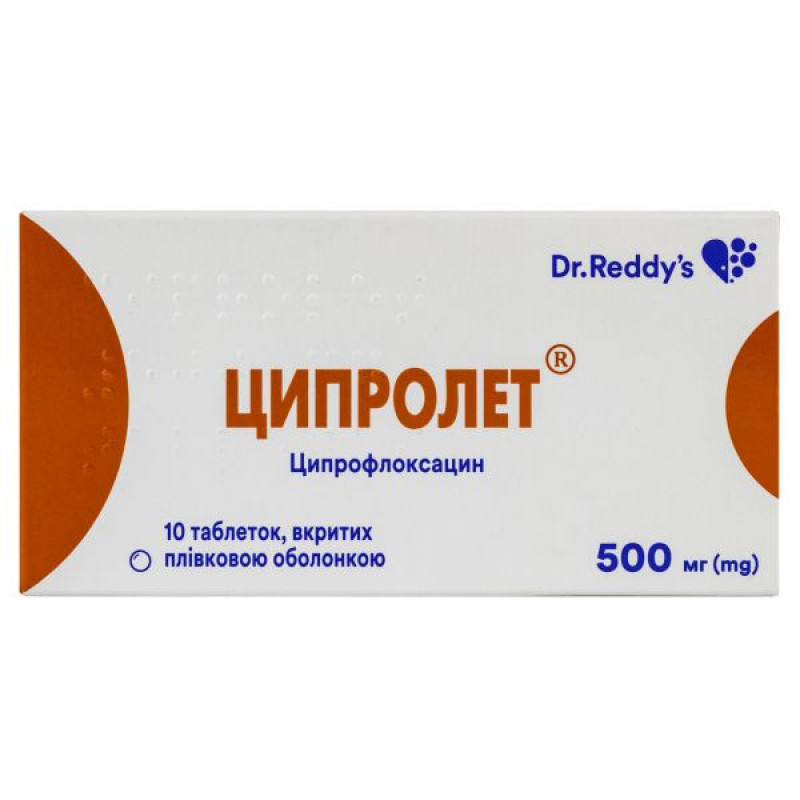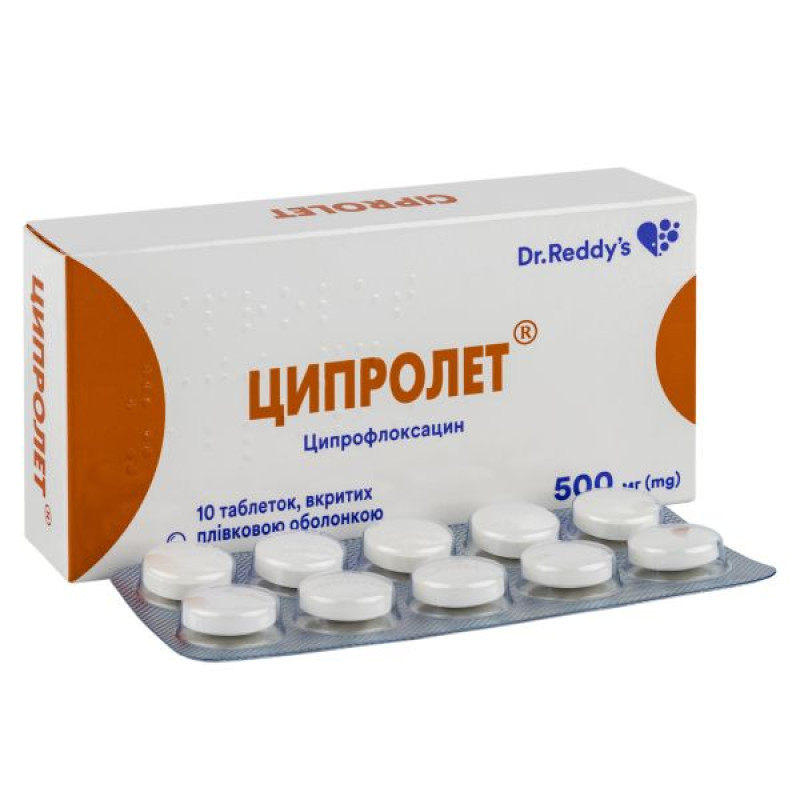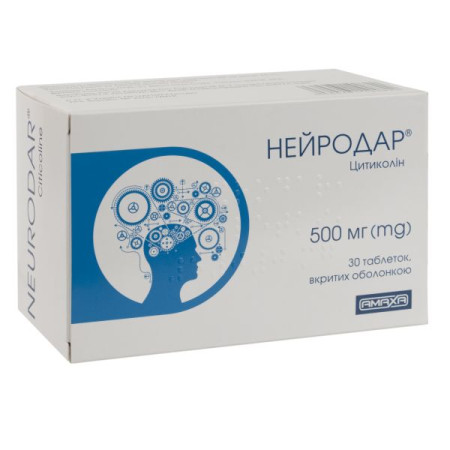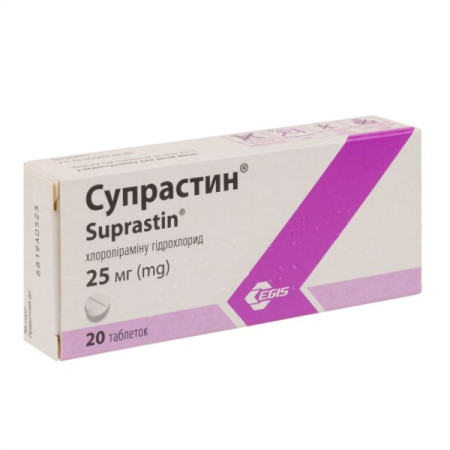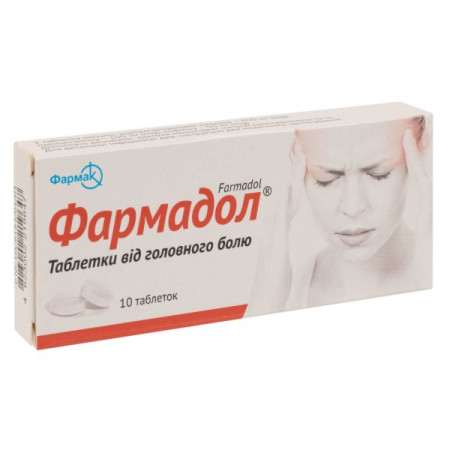Ciprolet film-coated tablets 500 mg No. 10
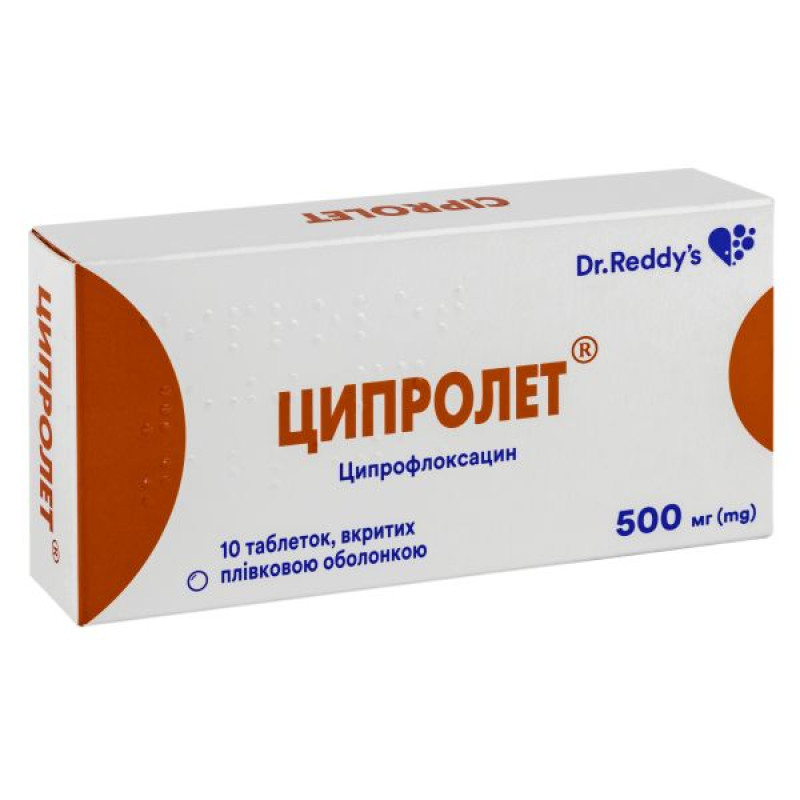
Instructions for Ciprolet film-coated tablets 500 mg No. 10
Composition
active ingredient: ciprofloxacin;
1 tablet contains ciprofloxacin hydrochloride equivalent to 250 mg or 500 mg of ciprofloxacin;
excipients: microcrystalline cellulose, talc, corn starch, colloidal anhydrous silica, magnesium stearate, croscarmellose sodium, hypromellose, sorbic acid, titanium dioxide (E 171), macrogol 6000, polysorbate 80, dimethicone.
Dosage form
Film-coated tablets.
Main physicochemical properties: white or almost white, round, biconvex tablets, film-coated.
Pharmacotherapeutic group
Antibacterials of the quinolone group. Fluoroquinolones. ATX code J01M A02.
Pharmacological properties
Pharmacodynamics
Ciprolet® is an antimicrobial drug of the fluoroquinolone group. The mechanism of action of ciprofloxacin is associated with the effect on DNA gyrase (topoisomerase) of bacteria, which plays an important role in the reproduction of bacterial DNA. Ciprolet® has a rapid bactericidal effect on microorganisms that are both dormant and multiplying.
The spectrum of action of the drug Ciprolet® includes the following types of gram-negative and gram-positive microorganisms: E. coli, Shigella, Salmonella, Citrobacter, Klebsiella, Enterobacter, Serratia, Hafnia, Edwardsiella, Proteus (indole-positive and indole-negative), Providencia, Morganella, Providencia, Yersinia, Vibrio, Aeromonas, Plesiomonas, Pasteurella, Haemophilus, Campylobact, Pseudomonas, Legionella, Neisseria, Moraxella, Branhamella, Acinetobacter, Brucella, Staphylococcus, Streptococcus agalactiae, Listeria, Corynebacterium, Chlamydia, as well as plasmid forms of bacteria. Gardnerella, Flavobacterium, Alciligenes, Streptococcus pyogenes, Streptococcus pneumoniae, Streptococcus viridans, Mycoplasma hominis, Mycobacterium tuberculosis, Mycobacterium fortuitum show different sensitivity. Anaerobes, with some exceptions, are moderately sensitive (Peptococcus, Peptostreptococcus) or resistant (Bacteroides). Ciprolet® is effective against bacteria that produce β-lactamases. Ciprolet® is active against pathogens resistant to almost all antibiotics, sulfonamides and nitrofuran drugs. The most commonly resistant are: Streptococcus faecium, Ureaplasma uralyticum, Nocardia asteroides, Treponema pallidum. Resistance to Ciprolet® develops slowly and gradually.
Pharmacokinetics
Ciprolet® is quickly and well absorbed after taking the drug (bioavailability is 50-85%). Maximum concentrations in blood plasma are reached after 60-90 minutes. The volume of distribution is 2-3 l/kg. Binding to blood plasma proteins is insignificant (20-40%). Ciprolet® penetrates well into organs and tissues, bones. Approximately 2 hours after oral administration, it is found in tissues and body fluids in concentrations that are many times higher than its concentration in blood serum.
Ciprolet® is excreted from the body mainly unchanged: mainly by the kidneys (50–70%). The half-life from blood plasma after oral administration is from 3 to 5 hours. A significant amount of the drug is also excreted with bile and feces (up to 30%), so only significant renal dysfunction leads to a slowdown in excretion.
Indication
Ciprolet® is indicated for the treatment of the following infections (see sections “Special instructions for use” and “Pharmacological properties”). Before starting therapy, special attention should be paid to all available information on resistance to ciprofloxacin.
Official recommendations on the appropriate use of antibacterial drugs should be taken into account.
Adults
Lower respiratory tract infections caused by gram-negative bacteria:
exacerbation of chronic obstructive pulmonary disease*;
bronchopulmonary infections in cystic fibrosis or bronchiectasis;
community-acquired pneumonia.
Chronic purulent otitis media.
Exacerbation of chronic sinusitis, especially if caused by gram-negative bacteria*.
Urinary tract infections:
uncomplicated acute cystitis*;
acute pyelonephritis;
complicated urinary tract infections;
bacterial prostatitis.
Gonococcal urethritis and cervicitis.
Epididymo-orchitis, particularly caused by Neisseria gonorrhoeae.
Pelvic inflammatory disease, particularly those caused by Neisseria gonorrhoeae.
In the above genital tract infections, when Neisseria gonorrhoeae is known or suspected as the causative agent, it is particularly important to obtain local information on ciprofloxacin resistance and confirm susceptibility based on laboratory tests.
Gastrointestinal tract infections (e.g., treatment of traveler's diarrhea).
Intra-abdominal infections.
Skin and soft tissue infections caused by gram-negative bacteria.
Bone and joint infections.
Fever in patients with neutropenia caused by bacterial infection.
Pulmonary form of anthrax (post-exposure prophylaxis and radical treatment).
Children and adolescents
Bronchopulmonary infections caused by Pseudomonas aeruginosa in patients with cystic fibrosis.
Complicated urinary tract infections and acute pyelonephritis.
Pulmonary form of anthrax (post-exposure prophylaxis and radical treatment).
Ciprofloxacin can also be used to treat severe infections in children and adolescents when the doctor considers it necessary.
* only if the use of other antibacterial agents that are usually prescribed to treat this infection is considered ineffective or inappropriate.
Contraindication
The drug should not be used in case of hypersensitivity to the active substance - ciprofloxacin - or to other drugs of the fluoroquinolone group, or to any of the excipients of the drug. The simultaneous use of ciprofloxacin and tizanidine is contraindicated (see section "Interaction with other medicinal products and other types of interactions").
Interaction with other medicinal products and other types of interactions
Effect of other drugs on ciprofloxacin
Chelate complex formation
The absorption of ciprofloxacin is reduced when ciprofloxacin is administered (orally) with medicinal products containing multivalent cations, mineral supplements (e.g. calcium, magnesium, aluminium, iron), phosphate-binding polymers (e.g. sevelamer), sucralfate or antacids, as well as medicinal products with a high buffer capacity (e.g. didanosine tablets) containing magnesium, aluminium or calcium. Therefore, ciprofloxacin should be taken either 1-2 hours before or at least 4 hours after taking these medicinal products.
This restriction does not apply to antacids belonging to the class of H2-receptor blockers.
Food and dairy products
Calcium in food has little effect on absorption. However, simultaneous administration of ciprofloxacin and dairy or mineral-fortified products (such as milk, yoghurt, calcium-fortified orange juice) should be avoided, as absorption of ciprofloxacin may be reduced.
Probenecid
Probenecid affects the renal secretion of ciprofloxacin. Concomitant use of probenecid-containing medicinal products and ciprofloxacin leads to an increase in serum ciprofloxacin concentrations.
Effect of ciprofloxacin on other drugs
Tizanidine
Tizanidine should not be administered concomitantly with ciprofloxacin (see section "Contraindications"). In a clinical study in healthy volunteers, concomitant administration of ciprofloxacin and tizanidine resulted in an increase in plasma tizanidine concentrations (7-fold increase in Cmax, range 4-21-fold; 10-fold increase in AUC, range 6-24-fold). Hypotensive and sedative adverse reactions are associated with increased serum tizanidine concentrations.
Methotrexate
Concomitant administration of ciprofloxacin may slow down the tubular transport (renal metabolism) of methotrexate, which may lead to an increase in the concentration of methotrexate in the blood plasma. This may increase the likelihood of adverse toxic reactions caused by methotrexate. Concomitant administration is not recommended (see section "Special instructions").
Theophylline
The simultaneous use of ciprofloxacin and drugs containing theophylline may lead to an undesirable increase in the concentration of theophylline in the blood serum, which, in turn, may cause the development of adverse reactions. In isolated cases, such adverse reactions may be life-threatening or fatal. If the simultaneous use of these drugs cannot be avoided, the concentration of theophylline in the blood serum should be monitored and its dose should be reduced appropriately (see section "Special instructions").
Other xanthine derivatives
Increased serum concentrations of these xanthines have been reported following concomitant use of ciprofloxacin and agents containing caffeine or pentoxifylline (oxpentifylline).
Phenytoin
Concomitant use of ciprofloxacin and phenytoin may result in increased or decreased serum concentrations of phenytoin, therefore monitoring of drug levels is recommended.
Vitamin K antagonists
Concomitant use of ciprofloxacin and vitamin K antagonists may potentiate their anticoagulant effects. Increased activity of oral anticoagulants has been reported in patients receiving antibacterial agents, particularly fluoroquinolones. The degree of risk may vary depending on the underlying infection, age, and general condition of the patient, and it is therefore difficult to accurately assess the effect of ciprofloxacin on the increase in the International Normalized Ratio (INR). Frequent monitoring of INR should be performed during and immediately after concomitant use of ciprofloxacin and vitamin K antagonists (e.g. warfarin, acenocoumarol, phenprocoumon, fluindione).
Ropinirole
In clinical studies, it was found that concomitant use of ropinirole with ciprofloxacin, a moderate inhibitor of the CYP450 1A2 isoenzyme, resulted in an increase in ropinirole AUC and Cmax by 60% and 84%, respectively. Monitoring of ropinirole side effects and appropriate dose adjustment are recommended during and immediately after co-administration with ciprofloxacin (see section 4.4).
Clozapine
After concomitant administration of 250 mg ciprofloxacin with clozapine for 7 days, serum concentrations of clozapine and N-desmethylclozapine were increased by 29% and 31%, respectively. Clinical monitoring and appropriate dose adjustment of clozapine are recommended during and immediately after concomitant administration with ciprofloxacin (see section 4.4).
Ciprolet®, like other fluoroquinolones, should be prescribed with caution to patients receiving drugs that prolong the QT interval (e.g. class IA and III antiarrhythmics, tricyclic antidepressants, macrolides, antipsychotics) (see section "Special warnings and precautions for use").
Metoclopramide
Metoclopramide accelerates the absorption of ciprofloxacin, resulting in a faster peak plasma concentration. No effect on the bioavailability of ciprofloxacin was observed.
Omeprazole
Concomitant use of ciprofloxacin and medicinal products containing omeprazole leads to a slight decrease in Cmax and AUC of ciprofloxacin.
Lidocaine
It has been shown that in healthy individuals, concomitant use of ciprofloxacin, a moderate inhibitor of cytochrome P450 1A2 isoenzymes, and lidocaine-containing medicinal products
reduces the clearance of intravenous lidocaine by 22%. Despite the normal tolerability of lidocaine treatment, an interaction with ciprofloxacin is possible, which is associated with adverse reactions and may develop with the concomitant use of these drugs.
Sildenafil
Cmax and AUC of sildenafil increased approximately twofold in healthy volunteers after oral administration of 50 mg sildenafil and concomitant administration of 500 mg ciprofloxacin. Therefore, caution should be exercised when co-administering Ciprolet® with sildenafil and the risk/benefit ratio should be considered.
Oral hypoglycemic agents
Hypoglycemia has been reported with concomitant administration of ciprofloxacin and oral antidiabetic agents, especially sulfonylureas (e.g. glibenclamide, glimepiride), possibly due to potentiation of the action of oral antidiabetic agents by ciprofloxacin (see section 4.8).
Duloxetine
Clinical studies have shown that concomitant use of duloxetine with strong CYP450 1A2 inhibitors, such as fluvoxamine, may result in increased AUC and Cmax of duloxetine. Although there are no clinical data on a possible interaction with ciprofloxacin, similar effects can be expected when these drugs are used concomitantly (see section 4.4).
Nonsteroidal anti-inflammatory drugs
Animal studies have shown that the combination of very high doses of quinolones (gyrase inhibitors) and certain nonsteroidal anti-inflammatory drugs (except acetylsalicylic acid) can provoke seizures.
Cyclosporine
Transient increases in plasma creatinine have been reported with concomitant administration of ciprofloxacin and cyclosporine-containing medicinal products. Therefore, frequent (twice weekly) monitoring of plasma creatinine concentrations is necessary in these patients.
Agomelatine
In clinical studies, fluvoxamine, a strong inhibitor of the CYP450 1A2 isoenzyme, was found to moderately inhibit the metabolism of agomelatine, resulting in a 60-fold increase in agomelatine exposure. Although no clinical data are available on a possible interaction with ciprofloxacin, a moderate inhibitor of CYP450 1A2, similar effects can be expected with its simultaneous use (see “Cytochrome P450” in the “Special Instructions” section).
Zolpidem
Concomitant administration of ciprofloxacin may increase the blood level of zolpidem, therefore concomitant use of these drugs is not recommended.
Sodium compounds
This medicinal product contains sodium compounds. 1 tablet of 250 mg contains 10 mg of croscarmellose sodium, 1 tablet of 500 mg contains 20 mg of croscarmellose sodium. Caution should be exercised when administering the drug to patients on a controlled sodium diet.
Application features
Ciprofloxacin should be avoided in patients who have had a history of serious adverse reactions to fluoroquinolones. Ciprofloxacin should only be initiated in such patients if no alternative treatment options are available and after a careful benefit-risk assessment (see section 4.3).
Severe infections and/or mixed infections caused by Gram-positive or anaerobic bacteria
Ciprofloxacin should not be used as monotherapy for the treatment of severe infections and infections caused by Gram-positive or anaerobic bacteria.
For the treatment of severe infections, infections caused by staphylococci or anaerobic bacteria, ciprofloxacin should be used in combination with appropriate antibacterial agents.
Streptococcal infections (including Streptococcus pneumoniae)
Ciprofloxacin is not recommended for the treatment of streptococcal infections due to insufficient efficacy.
Genital tract infections
Gonococcal urethritis, cervicitis, epididymo-orchitis and pelvic inflammatory disease,
may be caused by fluoroquinolone-resistant isolates of Neisseria gonorrhoeae.
Ciprofloxacin should be administered concomitantly with other appropriate antibacterial agents (e.g. cephalosporins), except in clinical situations where the presence of ciprofloxacin-resistant strains of Neisseria gonorrhoeae has been excluded. If clinical improvement does not occur after 3 days, therapy should be reviewed.
Fluoroquinolone resistance in Escherichia coli, the most common pathogen causing urinary tract infections, varies across the European Union. Physicians are advised to consider the local prevalence of fluoroquinolone resistance in Escherichia coli when prescribing treatment.
A single dose of ciprofloxacin, which can be used for uncomplicated cystitis in postmenopausal women, is expected to be less effective than a longer duration of treatment. This should be taken into account in the context of the increasing resistance of Escherichia coli to quinolones.
Intra-abdominal infections
Data on the efficacy of ciprofloxacin in the treatment of postoperative intra-abdominal infections are limited.
Traveler's diarrhea
When choosing a drug, information on the resistance to ciprofloxacin of relevant microorganisms in the countries visited by the patient should be taken into account.
Bone and joint infections
Ciprofloxacin should be used in combination with other antimicrobial agents depending on the results of microbiological testing.
Pulmonary form of anthrax
Use in humans is based on in vitro susceptibility data, animal studies and limited human data. The physician should follow national and/or international protocols for the treatment of anthrax.
Antibiotic-associated diarrhea caused by Clostridium difficile
Antibiotic-associated diarrhea caused by Clostridium difficile, which can range in severity from mild diarrhea to fatal colitis, has been reported with virtually all antibacterial agents, including ciprofloxacin. Antibacterial therapy alters the normal flora of the large intestine, which in turn leads to overgrowth of Clostridium difficile.
Clostridium difficile produces toxins A and B, which contribute to the development of antibiotic-associated diarrhea. Clostridium difficile produces large amounts of toxin, causing increased morbidity and mortality due to possible resistance of the pathogen to antimicrobial therapy and the need for colectomy. The possibility of antibiotic-associated diarrhea caused by Clostridium difficile should be considered in all patients with diarrhea after the use of antibiotics. A careful medical history is necessary, since antibiotic-associated diarrhea caused by Clostridium difficile may develop within 2 months of the use of antibacterial drugs. If the diagnosis of antibiotic-associated diarrhea caused by Clostridium difficile is considered or has already been confirmed, the use of antibiotics that are not effective against Clostridium difficile may need to be discontinued. Depending on clinical data, it is necessary to correct the water and electrolyte balance, consider the need for additional protein preparations, and use antibacterial drugs to which Clostridium difficile is sensitive. Surgical intervention may also be necessary.
Children and adolescents
The use of ciprofloxacin in children and adolescents should be carried out in accordance with current official recommendations. Treatment with ciprofloxacin should only be carried out by a physician experienced in the management of children and adolescents with cystic fibrosis and/or severe infections. Ciprofloxacin has caused arthropathy of the supporting joints in immature animals. Safety data from a randomised, double-blind study of ciprofloxacin in children (ciprofloxacin: n=335, mean age = 6.3 years; comparator group: n=349, mean age = 6.2 years; age range = 1 to 17 years) showed an incidence of arthropathy, which is probably related to the use of the drug (as distinct from clinical signs and symptoms related to direct joint damage), on the 42nd day from the start of the drug in the range of 7.2% and 4.6% for the main and comparator groups, respectively. The incidence of drug-related arthropathy after 1 year of follow-up was 9% and 5.7%, respectively. The increase in drug-related arthropathy was not statistically significant. However, treatment with ciprofloxacin in children and adolescents should only be initiated after a careful benefit-risk assessment due to the potential risk of adverse reactions involving the joints and/or surrounding tissues.
Bronchopulmonary infections in cystic fibrosis
Clinical trials included children and adolescents aged 5–17 years. There is more limited experience in children aged 1–5 years.
Complicated urinary tract infections and pyelonephritis
Treatment of urinary tract infections with ciprofloxacin should be considered when other treatments are not possible. Treatment should be based on microbiological results.
Clinical studies have evaluated the use of ciprofloxacin in children and adolescents aged 1–17 years.
Other specific severe infections
The use of ciprofloxacin in specific severe infections other than those mentioned above has not been evaluated in clinical trials and clinical experience is limited. Therefore, caution is recommended when treating patients with such infections.
Hypersensitivity to the drug
In some cases, hypersensitivity and allergic reactions may occur after the first dose of ciprofloxacin (see section "Adverse reactions"), which should be reported to the doctor immediately.
In rare cases, anaphylactic/anaphylactoid reactions may progress to a state of shock that is life-threatening. In some cases, they have been observed after the first dose of ciprofloxacin. In such cases, ciprofloxacin should be discontinued and medical treatment (treatment of anaphylactic shock) should be initiated immediately.
Musculoskeletal system
In general, ciprofloxacin should not be used in patients with a history of tendon diseases/disorders associated with the use of quinolones. However, in rare cases, after microbiological investigation of the pathogen and an assessment of the benefit/risk ratio, ciprofloxacin may be prescribed to these patients for the treatment of certain severe infections, namely in cases of failure of standard therapy or bacterial resistance, when microbiological results justify the use of ciprofloxacin. Tendinitis or tendon rupture (especially of the Achilles tendon), sometimes bilateral, may occur with ciprofloxacin, which may occur within the first 48 hours of treatment. Tendon ruptures have been reported several months after discontinuation of treatment with the drug. The risk of tendinopathy may be increased in elderly patients, in patients with impaired renal function, in patients who have undergone organ transplantation and in those taking corticosteroids concomitantly, therefore the concomitant use of corticosteroids with this drug should be avoided. (see section 4.8). If any signs of tendinitis (such as painful swelling, inflammation) occur, ciprofloxacin should be discontinued and alternative treatments considered. The affected limb should be rested and corticosteroids should not be used if there are signs of tendinopathy.
Ciprofloxacin should be used with caution in patients with myasthenia gravis due to possible exacerbation of the symptoms of this disease (see section "Adverse reactions").
Photosensitivity
Ciprofloxacin has been shown to cause photosensitivity reactions. Patients taking ciprofloxacin are advised to avoid direct sunlight or UV radiation during treatment (see section 4.8).
Vision impairment
If you experience blurred vision or any noticeable effect on your eyes, you should consult a doctor immediately.
Central nervous system
Quinolones cause convulsions or lower the seizure threshold. Ciprofloxacin should be used with caution in patients with CNS disorders who may be predisposed to seizures. If seizures occur, ciprofloxacin should be discontinued (see section 4.8). Psychotic reactions may occur even after the first dose of ciprofloxacin. In rare cases, depression or psychosis may progress to suicidal thoughts and actions, such as suicide or attempted suicide. In these cases, ciprofloxacin should be discontinued and appropriate measures should be taken in the clinical situation.
Peripheral neuropathy
Cases of sensory or sensorimotor polyneuropathy, manifested by paresthesia, hypesthesia, dysesthesia or weakness (based on neurological symptoms such as pain, burning, sensory disturbances or muscle weakness, alone or in combination), have been reported in patients taking ciprofloxacin. Ciprofloxacin should be discontinued in patients who experience symptoms of neuropathy, including pain, burning, tingling, numbness and/or weakness, and a physician should be consulted before continuing treatment with the drug, in order to prevent the development of irreversible conditions (see section "Adverse reactions").
Heart disorders
The use of ciprofloxacin has been associated with cases of QT prolongation (see section "Adverse reactions").
Fluoroquinolones, including ciprofloxacin, should be used with caution in patients with known risk factors for QT prolongation, including:
with hereditary QT prolongation syndrome;
in case of simultaneous use of drugs that may prolong the QT interval (e.g., class IA and III antiarrhythmics, tricyclic antidepressants, macrolides, neuroleptics);
with uncorrected electrolyte imbalance (e.g. hypokalemia, hypomagnesemia);
in case of heart disease (e.g. heart failure, myocardial infarction, bradycardia).
Women and elderly patients may be more sensitive to drugs that prolong QTc. Therefore, fluoroquinolones, including ciprofloxacin, should be used with caution in these groups of patients (see sections "Interaction with other medicinal products and other types of interactions", "Method of administration and dosage", "Overdose", "Adverse reactions").
If severe and persistent diarrhoea occurs during or after treatment (even several weeks after treatment), the doctor should be informed, as this symptom may mask a serious gastrointestinal disease (e.g. pseudomembranous colitis, which may be fatal) that requires immediate treatment (see section "Adverse reactions"). In such cases, ciprofloxacin should be discontinued and appropriate therapy should be initiated (e.g. vancomycin, 4 x 250 mg/day orally). Medicinal products that inhibit peristalsis are contraindicated.
Kidneys and urinary system
Since ciprofloxacin is excreted mainly unchanged by the kidneys, in patients with impaired renal function, dose adjustment is necessary as indicated in the "Method of administration and dosage" section to avoid an increase in the frequency of adverse reactions caused by accumulation of ciprofloxacin.
Crystalluria has been reported in association with the use of ciprofloxacin (see section 4.8). Patients receiving ciprofloxacin should be adequately hydrated. Excessive alkalinity of the urine should be avoided.
Hepatobiliary system
Cases of hepatic necrosis and life-threatening hepatic failure have been reported with ciprofloxacin (see section 4.8). If any signs and symptoms of liver disease (such as anorexia, jaundice, dark urine, pruritus or abdominal tenderness) occur, treatment should be discontinued. Transient increases in transaminases, alkaline phosphatase and cholestatic jaundice may also occur, especially in patients with pre-existing liver damage who have received ciprofloxacin (see section 4.8).
Glucose-6-phosphate dehydrogenase deficiency
Hemolytic reactions have been reported with ciprofloxacin in patients with glucose-6-phosphate dehydrogenase deficiency. Ciprofloxacin should be avoided in these patients unless the potential benefit outweighs the potential risk. In such cases, hemolysis should be observed.
Resistance
During or after a course of ciprofloxacin treatment, resistant bacteria may be isolated with or without clinically apparent superinfection. There may be a certain risk of isolation of ciprofloxacin-resistant bacteria during long courses of treatment and in the treatment of nosocomial infections and/or infections caused by Staphylococcus and Pseudomonas species.
Cytochrome P450
Ciprofloxacin moderately inhibits CYP450 1A2 and may therefore lead to increased serum concentrations of concomitantly administered substances that are also metabolised by this enzyme (e.g. theophylline, methylxanthines, caffeine, duloxetine, clozapine, olanzapine, ropinirole, tizanidine, agomelatine). Concomitant administration of ciprofloxacin and tizanidine is contraindicated. The increase in plasma concentrations associated with drug-specific adverse reactions is due to inhibition of their metabolic clearance by ciprofloxacin. Therefore, patients taking these drugs concomitantly with ciprofloxacin should be closely monitored for clinical signs of overdose. Serum concentrations of the drug (e.g. theophylline) may also need to be determined (see section 4.5).
Methotrexate
The simultaneous administration of ciprofloxacin and methotrexate is not recommended (see section "Interaction with other medicinal products and other types of interactions").
Impact on laboratory test results
Ciprofloxacin may interfere with culture results for Mycobacterium spp. in vitro by inhibiting the growth of mycobacterial cultures, which may lead to false-negative culture results in patients taking ciprofloxacin.
Patients at increased risk of aneurysm, aortic dissection, and regurgitation/valvular heart failure
Epidemiological studies report an increased risk of aortic aneurysm and dissection, especially in elderly patients, as well as aortic and mitral valve regurgitation after taking fluoroquinolones.
Cases of aortic aneurysm and dissection, sometimes complicated by rupture (including fatal cases), and regurgitation/insufficiency of any of the heart valves have been reported in patients receiving fluoroquinolones (see section 4.8).
Therefore, fluoroquinolones should only be used after careful benefit-risk assessment and after consideration of other treatment options in patients with a positive family history of aneurysm or congenital heart valve disease, or in patients with an existing diagnosis of aortic aneurysm and/or aortic dissection, or heart valve disease, or in the presence of other risk factors or predisposing conditions:
The risk of aortic aneurysm and dissection and their rupture may be increased in patients receiving concomitant systemic corticosteroids.
Patients should seek immediate medical attention in the emergency department if they experience sudden abdominal, chest, or back pain.
Patients should be advised to seek immediate medical attention in the event of acute shortness of breath, new onset of palpitations, or development of abdominal or lower extremity edema.
Fluctuations in blood glucose levels
Fluoroquinolones may cause disturbances in blood glucose levels, including hyperglycemia and hypoglycemia (see section "Adverse reactions"), usually in diabetic patients receiving concomitant treatment with oral hypoglycemic agents (e.g. glibenclamide) or insulin. Severe cases of hypoglycemia, leading to coma, have been reported. Close monitoring of blood glucose levels is recommended in such patients.
Long-term, disabling, potentially irreversible serious adverse reactions.
Very rarely, long-lasting (several months to years), disabling, potentially irreversible serious adverse reactions affecting various, sometimes simultaneously, organ systems (musculoskeletal, nervous, mental and sensory) have been reported in patients treated with quinolones and fluoroquinolones, regardless of age or previously identified risk factors. Ciprofloxacin should be discontinued immediately at the first signs or symptoms of any serious adverse reactions and a doctor should be consulted immediately.
Use during pregnancy or breastfeeding
Pregnancy.
Data on the use of ciprofloxacin in pregnant women demonstrate the absence of malformations or feto/neonatal toxicity. Animal studies do not indicate direct or indirect toxic effects on reproductive function. In young animals and animals exposed to quinolones before birth, effects on immature cartilage tissue have been observed, so the possibility that the drug may be harmful to the articular cartilage of the newborn/fetus cannot be excluded. Therefore, as a precaution, it is better to avoid taking ciprofloxacin during pregnancy.
Breastfeeding period.
Ciprofloxacin passes into breast milk. Due to the potential risk of damage to articular cartilage in newborns, ciprofloxacin should not be used during breast-feeding.
Ability to influence reaction speed when driving vehicles or other mechanisms
Fluoroquinolones, to which ciprofloxacin belongs, may affect the patient's ability to drive and use machines due to CNS reactions (see section "Adverse reactions"). Therefore, the ability to drive and use machines may be impaired.
Method of administration and doses
The dose should be determined according to the indication, severity and site of the infection, the sensitivity of the causative organism(s) to ciprofloxacin, the patient's renal function, and in children and adolescents - according to body weight.
The duration of treatment depends on the severity of the disease, the characteristics of the clinical picture, and the type of pathogen.
Treatment of infections caused by certain bacteria (e.g. Pseudomonas aeruginosa, Acinetobacter or Staphylococci) may require the use of higher doses of ciprofloxacin and the concomitant administration of other necessary antibacterial drugs.
Treatment of certain infections (e.g. inflammatory diseases of the small
There are no reviews for this product.
There are no reviews for this product, be the first to leave your review.
No questions about this product, be the first and ask your question.




